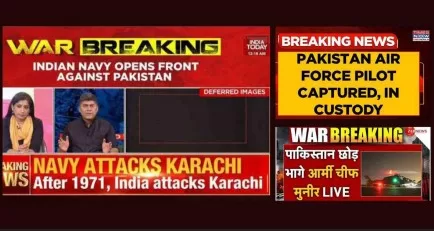“Karachi port has been destroyed.” “Pakistan’s nuclear facilities have been neutralized.” “Islamabad and Rawalpindi lie in ruins.” “India has downed two Pakistani Fighter jets.” These were just a few of the frenzied headlines churned out by the Indian mainstream media during the recent crisis.
With every fabricated bulletin, the Indian media didn’t just damage its own credibility; it severely dented, irrevocably, the already fragile image of the Indian state, exposing a disturbing alignment between hysteria, deception, and national ambition.
Over 125 deliberate falsehoods were aired as breaking news. What played out on television screens across India wasn’t journalism, it was theatre. Across the border, these scenes often evoked laughter, not because the lies were clever, but because they were so blatantly absurd. Anchors posing as war strategists, newsrooms performing like stage sets, and graphics spinning fantasies. But behind the buffoonery lies a serious and dangerous truth: Indian media has formally abandoned its role as a guardian of public interest. It is now a primary vehicle for state propaganda.
A global survey conducted by the World Economic Forum between 4th September and 9th October 2023, based on the insights of 1,490 experts in government, academia, business, and civil society, India was ranked first, as the Country “Where false information is posing the Biggest threat.”
That grading materialized fully in April 2025, when Indian media declared a full-scale psychological war, not just against Pakistan, but against truth itself, surpassing its scintillating gold standard many times over. Media, by definition, is a system of information transmission, an institution as old as civilization. From primitive symbols to Gutenberg’s press in the 1440s, the media has shaped ideas, revolutions, and regimes. In the Renaissance, Martin Luther’s rebellion against religious authority was amplified by the printed word, as he famously called the printing press “the greatest gift of God”, becoming the First best-selling author. In the modern age, media has become an instrument of soft power. The British were the first ones to realize its impact and founded the BBC in 1922 on “The Reithian Principles”: Inform, Educate and Entertain, based on Accuracy, Impartiality and Fairness. Its authority lasted for decades. Even as channels like CNN, Al Jazeera, TRT, and CGTN entered the field, the foundation remained the same: power over narrative must be built on proximity to truth.
India’s media painted Pakistan as the aggressor without a shred of evidence, invoking the fantasy of Akhand Bharat and pouring venom on Pakistani leadership. The diplomatic crisis reached new lows when even the Foreign Minister of Iran was targeted. The hysteria was not limited to foreign actors. The Indian Foreign Secretary Vikram Misri and his family were subjected to abuse and threats following the announcement of a ceasefire. The same media that swore allegiance to nationalism turned on its own officials when they failed to feed the war narrative. That is the depth of decay. Communal poison was stirred in with abandon. By linking fabricated attacks to Pakistan and organizations like JeM, the media knowingly endangered the lives of over 150 million Indian Muslims. Islamophobia was not a side-effect, it was the strategy. It served both to unify the majority in anger and to deepen internal divisions.
Legal tools were swiftly deployed to ensure absolute editorial submission. With the passage of the 2023 Digital Personal Data Protection Act and the Telecommunications Act, the Indian government secured complete control over digital content. Media platforms knew the consequences of defiance: lawsuits, shutdowns, or worse. So they became partners.
Ownership patterns did the rest. Major news channels, including NDTV and others, are now controlled by industrial giants like the Adani Group and Reliance. What airs on television is decided not by editorial boards, but by boardrooms. News has become a subsidiary of business, and business serves the state.
The pursuit of ratings finished the job. Social media platforms like WhatsApp, YouTube, and Facebook were transformed into weapons of narrative warfare. With over 500 million users, the battlefield was enormous, and the Indian media flooded it with misinformation, doctored images, and hate speech disguised as journalism.
What has emerged is not media failure, it is systemic collapse. The international community has taken notice. India now ranks 161st on the World Press Freedom Index for 2024, trailing countries with no tradition of press liberty. Once praised as a vibrant democracy, India’s media now stands discredited and distrusted. It has not been silenced. It has been bought, conscripted, and unleashed.
Against this backdrop, Pakistan responded with clarity, composure, and credibility. While Indian networks screamed of victories that never occurred, Pakistani media remained rooted in facts and restraint.
Our media didn’t resort to fiction, nor did it manufacture heroes. It stayed focused on the truth, messaging peace, and exposing lies with dignity. In the information war, this was the real victory. But it would be naive to believe that this was the end. What played out was not a one-off spectacle. It was doctrine in motion. A nation that has weaponized its media so completely will not hesitate to repeat the strategy. Another manufactured crisis, another media blitz, another lie, it is only a matter of time.
Indian media today does not reflect a democratic society; it reflects a dangerous fusion of ideology, corporatism, and authoritarian ambition. It is not failing; it is functioning exactly as intended. It lies because it is required to. It incites because it is rewarded for doing so. The cameras are Indian. The voice is that of the state. And the script is written by those who have replaced facts with flags. Pakistan didn’t just prevail over a military provocation; it defeated a psychological assault. It exposed a media empire built on fabrication. The world has seen it. So has history. And history never forgets.





